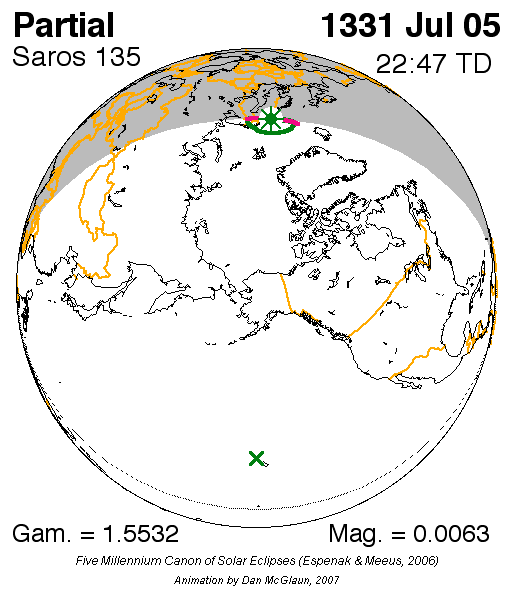Solar Saros 135 on:
[Wikipedia]
[Google]
[Amazon]


 Saros cycle series 135 for
Saros cycle series 135 for
Saros cycle 135 - Information and visualization
{{Solar eclipses Solar saros series


 Saros cycle series 135 for
Saros cycle series 135 for solar eclipse
A solar eclipse occurs when the Moon passes between Earth and the Sun, thereby obscuring the view of the Sun from a small part of Earth, totally or partially. Such an alignment occurs approximately every six months, during the eclipse season i ...
s occurs at the Moon's ascending node
In general, a node is a localized swelling (a "knot") or a point of intersection (a vertex).
Node may refer to:
In mathematics
* Vertex (graph theory), a vertex in a mathematical graph
*Vertex (geometry), a point where two or more curves, lines ...
, repeating every 18 years, 11 days, containing 71 eclipses, including 53 umbral eclipses (45 annular, 2 hybrid, 6 total). The longest duration of totality will be 2 minutes, 27 seconds on May 12, 2431 while the longest annular was 10 minutes 14 seconds on 24 December 1601.
This solar saros is linked to Lunar Saros 128.
This series included the smallest annular solar eclipse in the 2nd millennium
File:2nd millennium montage.png, From top left, clockwise: in 1492, Christopher Columbus reaches the New World, opening the European colonization of the Americas; the American Revolution, one of the late 1700s Enlightenment-inspired Atlantic Rev ...
on 24 December 1601, with an eclipse magnitude of only 0.90785, just 0.002% larger than the solar eclipse of 12 November 1683 BCE, which was the smallest annular solar eclipse of thousands of years, with an eclipse magnitude of only 0.90783.
The factors that made this such a small annular solar eclipse were:
* The Earth being very near perihelion
An apsis (; ) is the farthest or nearest point in the orbit of a planetary body about its primary body. The line of apsides (also called apse line, or major axis of the orbit) is the line connecting the two extreme values.
Apsides perta ...
(closest approach from the Sun in its elliptical orbit, making its angular diameter nearly as large as possible). This occurs around January 3.
* The Moon being nearly exactly at apogee (making its angular diameter as small as possible). The moment of greatest eclipse was just a day before apogee.
* The midpoint of the eclipse occurring when the Sun was close to the horizon (increasing the distance to the Moon by a greater percentage than the distance to the Sun).
Umbral eclipses
Umbral eclipses (annular, total and hybrid) can be further classified as either: 1) Central (two limits), 2) Central (one limit) or 3) Non-Central (one limit). The statistical distribution of these classes in Saros series 135 appears in the following table.All eclipses
Note: Dates are given in theJulian calendar
The Julian calendar is a solar calendar of 365 days in every year with an additional leap day every fourth year (without exception). The Julian calendar is still used as a religious calendar in parts of the Eastern Orthodox Church and in parts ...
prior to 15 October 1582, and in the Gregorian calendar
The Gregorian calendar is the calendar used in most parts of the world. It went into effect in October 1582 following the papal bull issued by Pope Gregory XIII, which introduced it as a modification of, and replacement for, the Julian cale ...
after that.
Notes
References
* https://eclipse.gsfc.nasa.gov/SEsaros/SEsaros135.htmlExternal links
Saros cycle 135 - Information and visualization
{{Solar eclipses Solar saros series